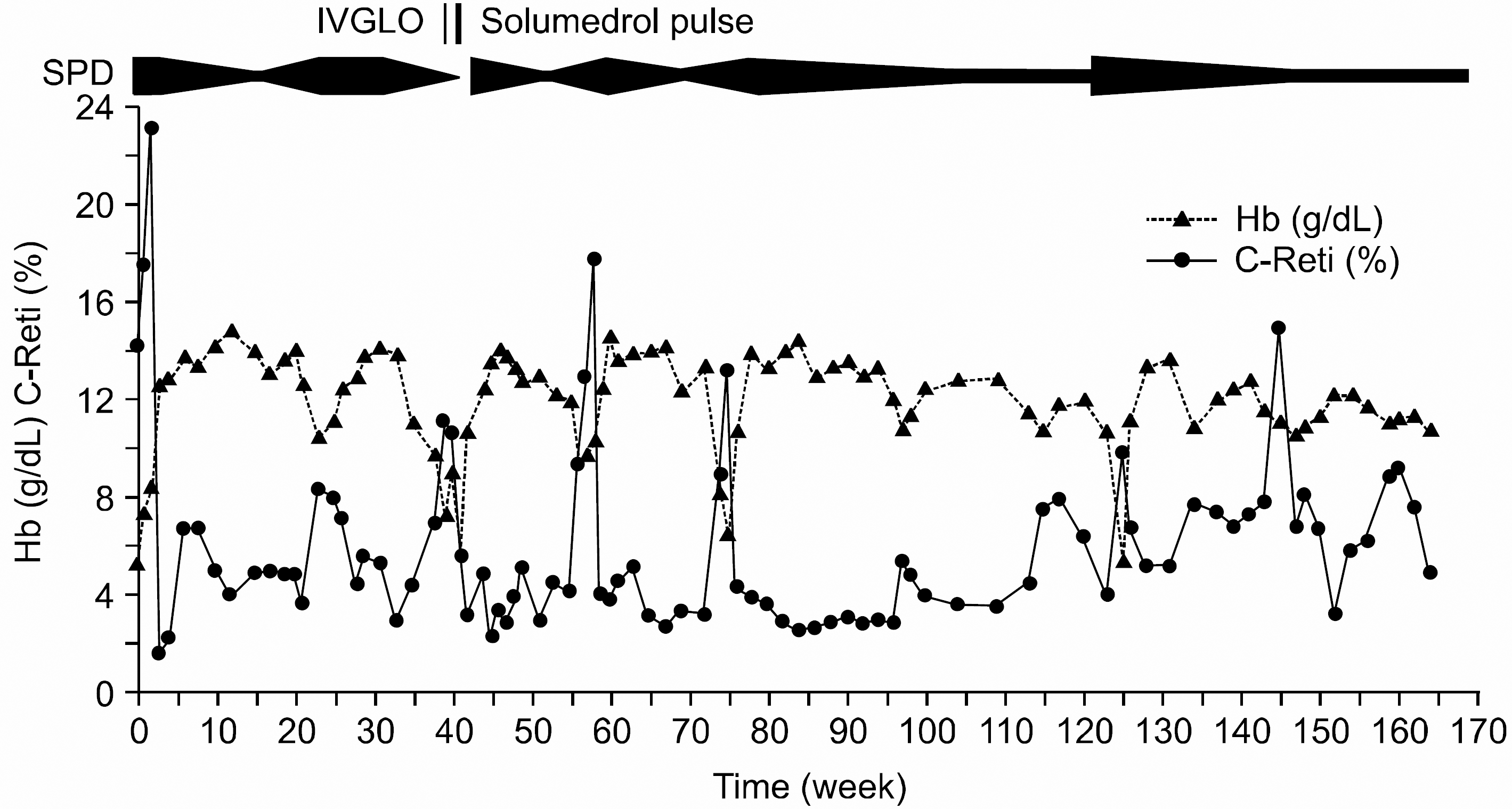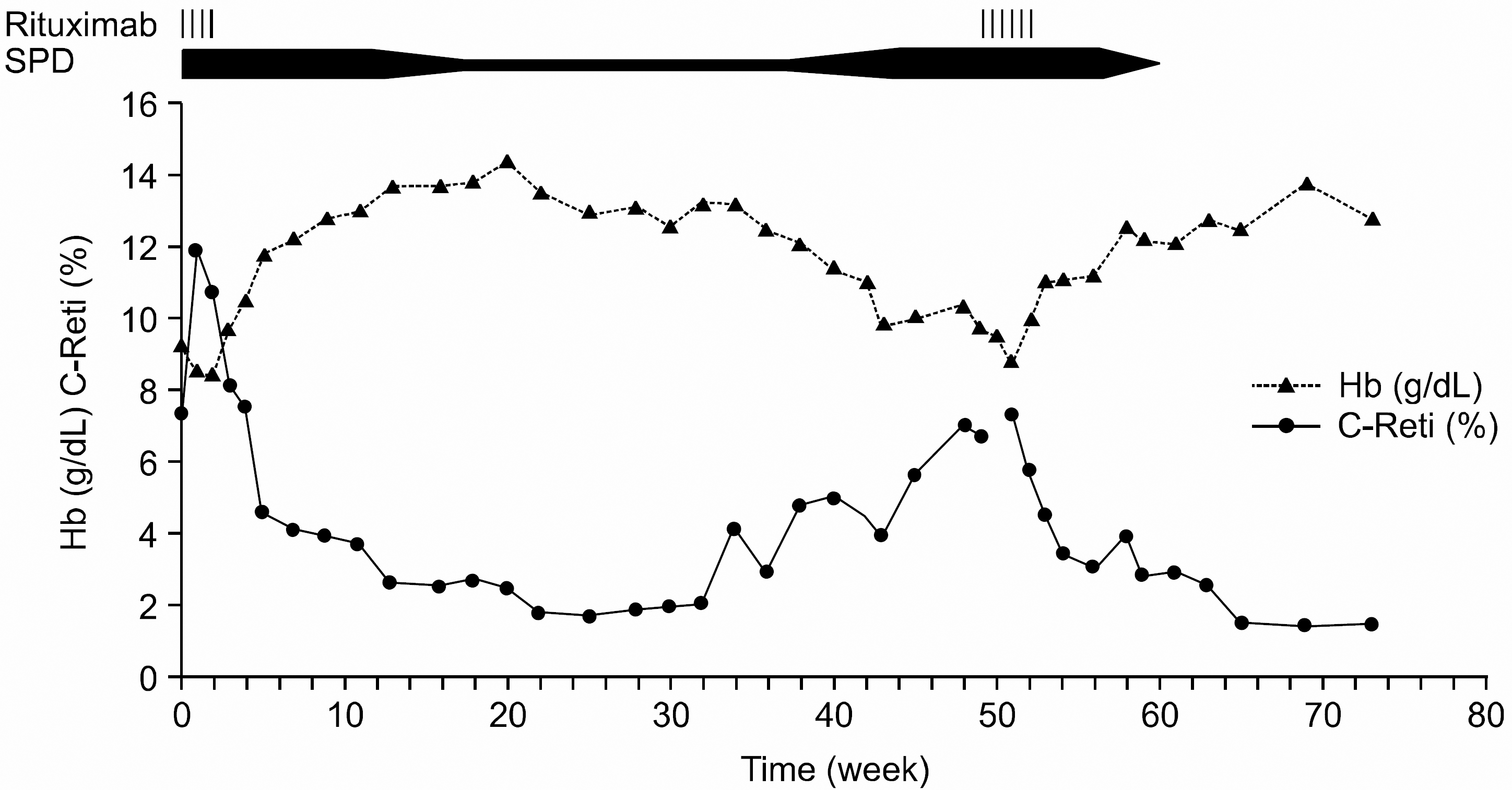Abstract
Autoimmune hemolytic anemia (AIHA) in children usually responds well to short-term steroid therapy. However, in some cases, AIHA requires prolonged immunosuppressive therapy, with the subsequent development of severe side effects. Compared with previous conventional immunosuppressive therapy, rituximab, an anti-CD20 chimeric monoclonal antibody, shows good therapeutic efficacy and safety in the treatment of autoimmune disorders. Herein, the case of a 13-year-old male patient, who showed a remarkable and durable response to rituximab, at a dose of 375mg/m2, is reported. Before this trial, he had been a hepatitis B carrier and steroid dependent AIHA for 4 years, with a cushingoid facial appearance and growth retardation. After 10 months, he experienced a recurrence of hemolysis, which was successfully retreated, and was then taken off the steroid therapy. The therapy was well tolerated, without serious complications. It is suggested that rituximab could be a new option in the treatment of steroid-dependent AIHA. Therefore, long-term follow-up and studies of the risk factors of a relapse are warranted.
Go to : 
REFERENCES
1). George BS. Hemolytic anemias resulting from extracellular factors. Behrman RE, Kliegman RM, Jenson HB, editors. Nelson textbook of pediatrics. 17th ed.Philadelphia: WB Saunders Co;2004. p. 1638–40.
2). Reff ME., Carner K., Chambers KS, et al. Depletion of B cells in vivo by a chimeric mouse human monoclonal antibody to CD20. Blood. 1994. 83:435–45.

3). McLaughlin P., Grillo-Lopez AJ., Link BK, et al. Rituximab chimeric anti-CD20 monoclonal antibody therapy for relapsed indolent lymphoma: half of patients respond to a four-dose treatment program. J Clin Oncol. 1998. 16:2825–33.

4). Yang DH., Lee JJ., Kim YK, et al. The clinical efficacy of R-CHOP chemotherapy in patients with previously untreated diffuse large B-cell lymphoma. Korean J Hematol. 2004. 39:59–65.
6). Quartier P., Brethon B., Philippet P., Landman-Parker J., Le Deist F., Fischer A. Treatment of childhood autoimmune haemolytic anaemia with rituximab. Lancet. 2001. 358:1511–3.

7). Zecca M., Nobili B., Ramenghi U, et al. Rituximab for the treatment of refractory autoimmune hemolytic anemia in children. Blood. 2003. 101:3857–61.

8). Ramanathan S., Koutts J., Hertzberg MS. Two cases of refractory warm autoimmune hemolytic anemia treated with rituximab. Am J Hematol. 2005. 78:123–6.

9). Wang J., Wiley JM., Luddy R., Greenberg J., Feuer-stein MA., Bussel JB. Chronic immune thrombocytopenic purpura in children: assessment of rituixmab treatment. J Pediatr. 2005. 146:217–21.
10). Park SJ., Han CW. The long term remission effect of rituximab in two patients with autoimmune-associated cytopenias that were refractory to standard treatments. Korean J Hematol. 2005. 40:101–5.

11). Park US., Choi CB., Kim JS, et al. A case of post-transplantation lymphoproliferative disease developed in renal transplant recipient and treated with rituximab. Korean J Med. 2004. 67:94–9.
12). Heisel MA., Ortega JA. Factors influencing prognosis in childhood autoimmune hemolytic anemia. Am J Pediatr Hematol Oncol. 1983. 5:147–52.
Go to : 




 PDF
PDF ePub
ePub Citation
Citation Print
Print




 XML Download
XML Download